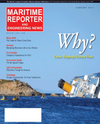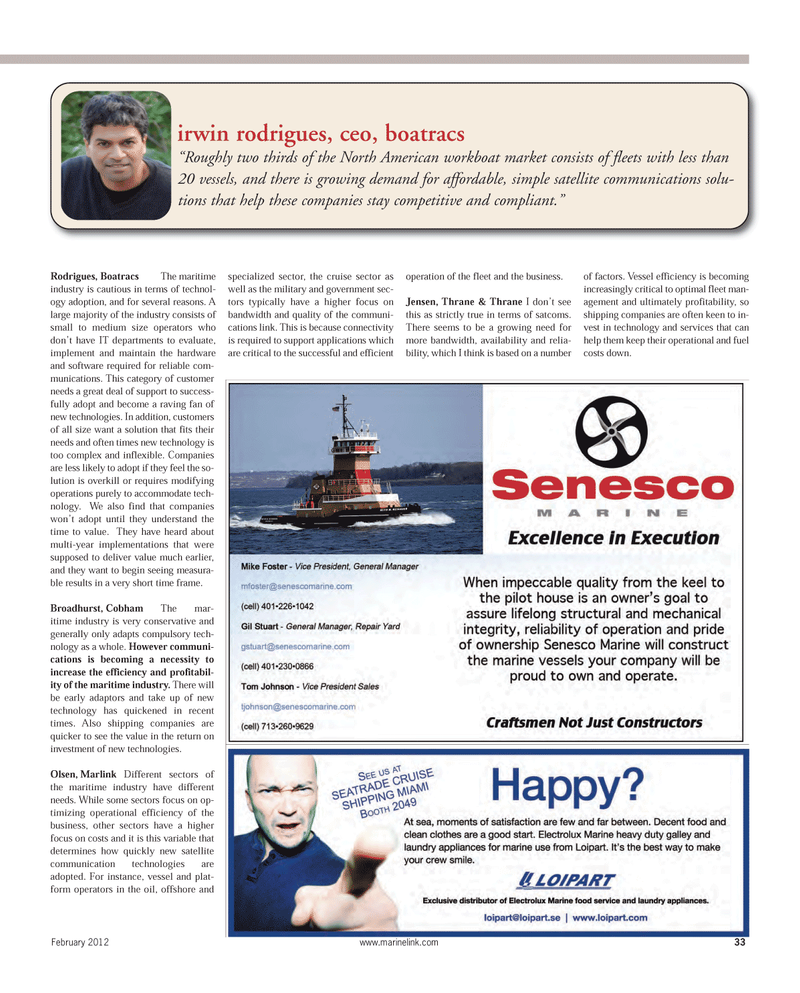
Page 33: of Maritime Reporter Magazine (February 2012)
Cruise Shipping Annual
Read this page in Pdf, Flash or Html5 edition of February 2012 Maritime Reporter Magazine
Rodrigues, BoatracsThe maritimeindustry is cautious in terms of technol-ogy adoption, and for several reasons. A large majority of the industry consists of small to medium size operators whodon?t have IT departments to evaluate, implement and maintain the hardware and software required for reliable com- munications. This category of customer needs a great deal of support to success-fully adopt and become a raving fan of new technologies. In addition, customers of all size want a solution that fits their needs and often times new technology is too complex and inflexible. Companies are less likely to adopt if they feel the so- lution is overkill or requires modifying operations purely to accommodate tech-nology. We also find that companies won?t adopt until they understand the time to value. They have heard about multi-year implementations that weresupposed to deliver value much earlier, and they want to begin seeing measura- ble results in a very short time frame. Broadhurst, Cobham The mar- itime industry is very conservative and generally only adapts compulsory tech-nology as a whole. However communi- cations is becoming a necessity toincrease the efficiency and profitabil- ity of the maritime industry. There willbe early adaptors and take up of new technology has quickened in recent times. Also shipping companies are quicker to see the value in the return on investment of new technologies. Olsen, MarlinkDifferent sectors of the maritime industry have different needs. While some sectors focus on op- timizing operational efficiency of the business, other sectors have a higher focus on costs and it is this variable that determines how quickly new satellite communication technologies areadopted. For instance, vessel and plat- form operators in the oil, offshore and specialized sector, the cruise sector as well as the military and government sec- tors typically have a higher focus on bandwidth and quality of the communi-cations link. This is because connectivity is required to support applications whichare critical to the successful and efficient operation of the fleet and the business. Jensen, Thrane & Thrane I don?t see this as strictly true in terms of satcoms.There seems to be a growing need for more bandwidth, availability and relia- bility, which I think is based on a number of factors. Vessel efficiency is becoming increasingly critical to optimal fleet man-agement and ultimately profitability, so shipping companies are often keen to in- vest in technology and services that can help them keep their operational and fuel costs down. February 2012www.marinelink.com 33irwin rodrigues, ceo, boatracs ?Roughly two thirds of the North American workboat market consists of fleets with less than 20 vessels, and there is growing demand for affordable, simple satellite communications solu- tions that help these companies stay competitive and compliant.? MR Feb.12 # 4 (26-33):MR Template 2/7/2012 9:44 AM Page 33

 32
32

 34
34
